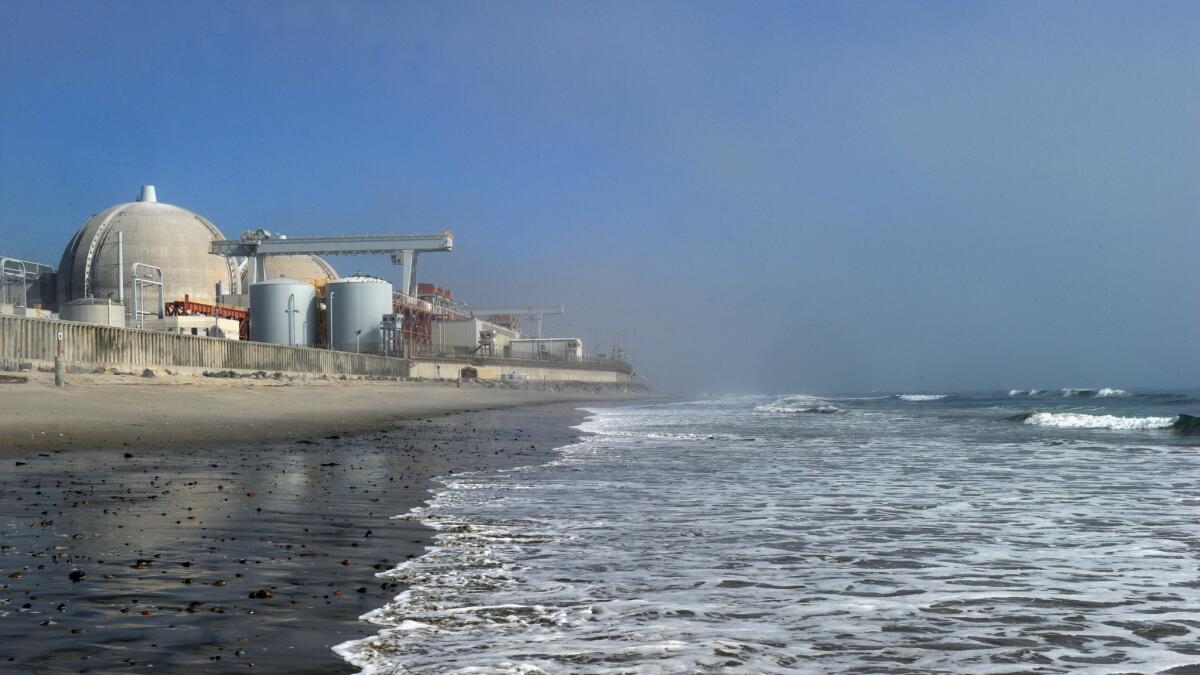Edison calls settlement that left consumers on hook for $3.3 billion reasonable

- Share via
Southern California Edison on Thursday warned that its customers could face higher costs related to the shuttered San Onofre nuclear plant if regulators overturn a settlement agreement.
In an 80-page filing with the California Public Utilities Commission, Edison argued that the agreement reached over San Onofre’s closure should stand based on past legal precedent involving other settlement agreements and the normal process of closing power plants.
The utility’s filing was its first detailed response to an order that could lead to full reconsideration of the settlement agreement, which left consumers on the hook for $3.3 billion to permanently close the nuclear plant in 2013.
Edison argued that under the agreement customers were only paying for past investments to build and maintain the nuclear plant — not the mistakes that led to its closure.
Reconsidering the settlement could increase customer payments, the utility said.
“We believe this public process will allow interested parties to review the settlement and confirm for themselves that it should stand,” Ron Nichols, Edison’s president, said in a statement.
Consumer advocates filed their own arguments Thursday in favor of reconsidering the settlement. They argue that Edison should be held responsible for the premature closure of San Onofre in June 2013 after faulty replacement steam generators were installed at the plant.
The advocates, led by San Diego lawyer Michael Aguirre, a former assistant U.S. attorney, also maintain that Edison’s failure to report back-channel communication between Edison representatives and commission representatives about San Onofre’s closure cloud the integrity of the agreement.
“Before the PUC can take any corrective steps on San Onofre, the circle of officials who knew about the secret San Onofre deal … have to step away,” Aguirre said in an interview. He said the “prefabricated agreement” hurts public confidence.
In May, public utilities Commissioner Catherine J.K. Sandoval and Administrative Law Judge Maribeth Bushey issued the ruling to reopen the case in large part because of the revelations about the unreported talks.
In particular, the ruling cited a meeting between Michael Peevey, who was commission president, and Stephen Pickett, who was Edison’s vice president for external relations, during an energy industry junket in Warsaw, Poland.
Regulators in December fined Edison $16.7 million for failing to report the talks.
“In light of our December 2015 penalty levied against Edison … it is prudent to review whether the settlement reached before those disclosures remains in the public interest and in accordance with our settlement rules,” Sandoval wrote in May. “It is important to reopen the record and hear from the parties through their filings in the CPUC’s proceeding.”
The settlement agreement was designed to resolve how $4.7 billion in expenses related to the nuclear plant would be paid.
The agreement stated that consumers would be responsible for $3.3 billion of the costs and shareholders of Edison and San Diego Gas & Electric, which together owned the plant, would shoulder the rest.
Out of the $3.3 billion, Edison customers were assigned most of the costs – about $2.5 billion.That has amounted to about $2 a month for the average residential customer.
Some of the consumer burden has been reduced because of insurance payments and other credits. Edison now says that its customers’ costs are down to $2 billion. That number could drop even further, the utility argues, if it is successful in a lawsuit with the contractor that handled the steam generator replacement.
Edison notes the utility’s shareholders paid $696 million for the steam generators themselves, while customers paid $168 million, which covered the period in which the generators were working.
“Our shareholders, and not customers, are appropriately paying for the faulty steam generators from the day they were no longer providing power,” Nichols stated. “The portion of customers’ bills attributable to San Onofre is not related to the faulty steam generators, but to pay for other reasonable investments in a plant that provided safe, reliable, low-cost power for nearly 30 years.”
Follow me at @ivanlpenn
ALSO
PG&E to close Diablo Canyon, California’s last nuclear power plant
First audit in 20 years finds a lot wrong with the agency that regulates your utilities
Edison will spend $12 billion on electric system over next three years
More to Read
Inside the business of entertainment
The Wide Shot brings you news, analysis and insights on everything from streaming wars to production — and what it all means for the future.
You may occasionally receive promotional content from the Los Angeles Times.











